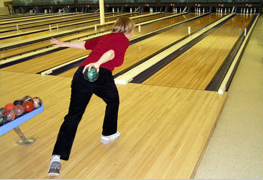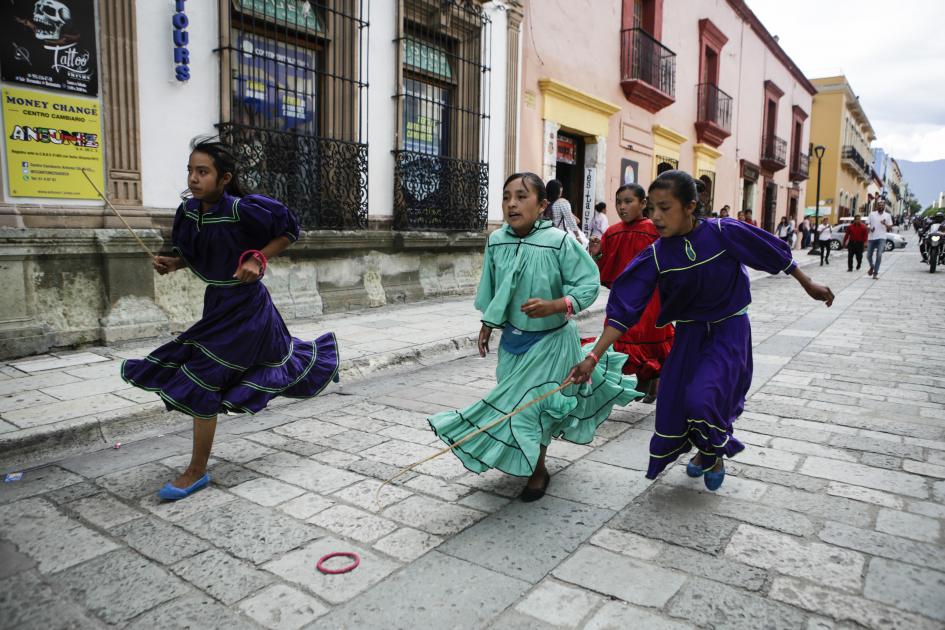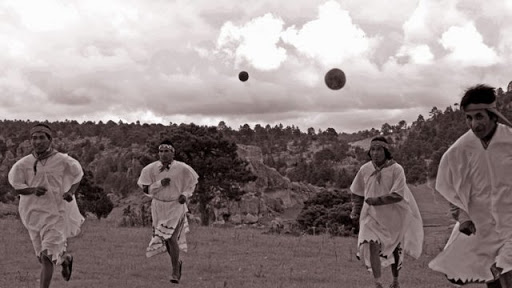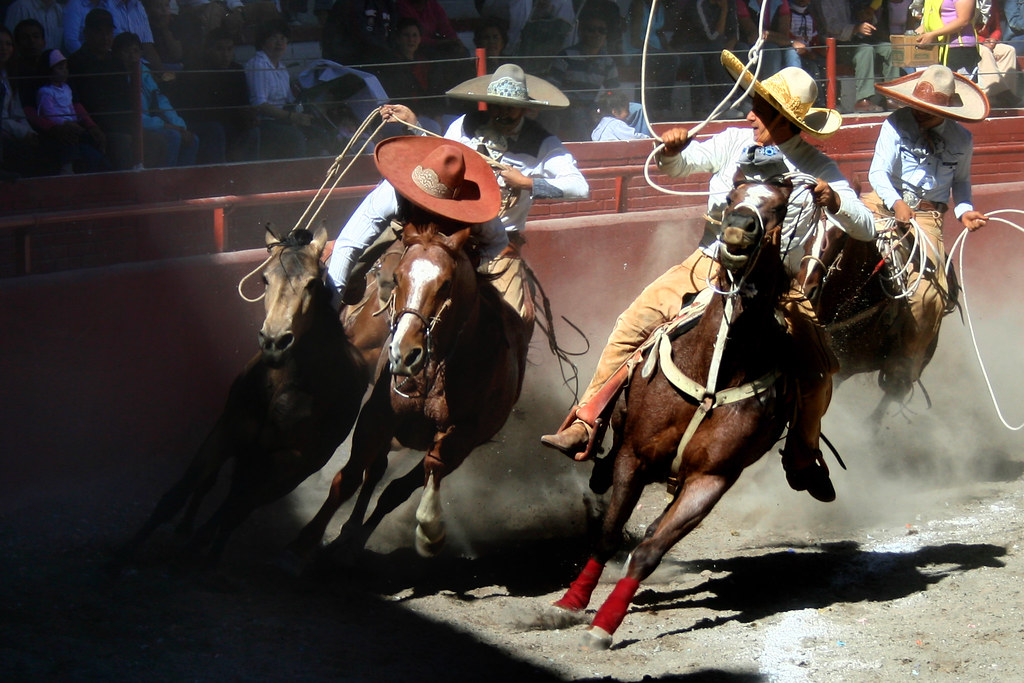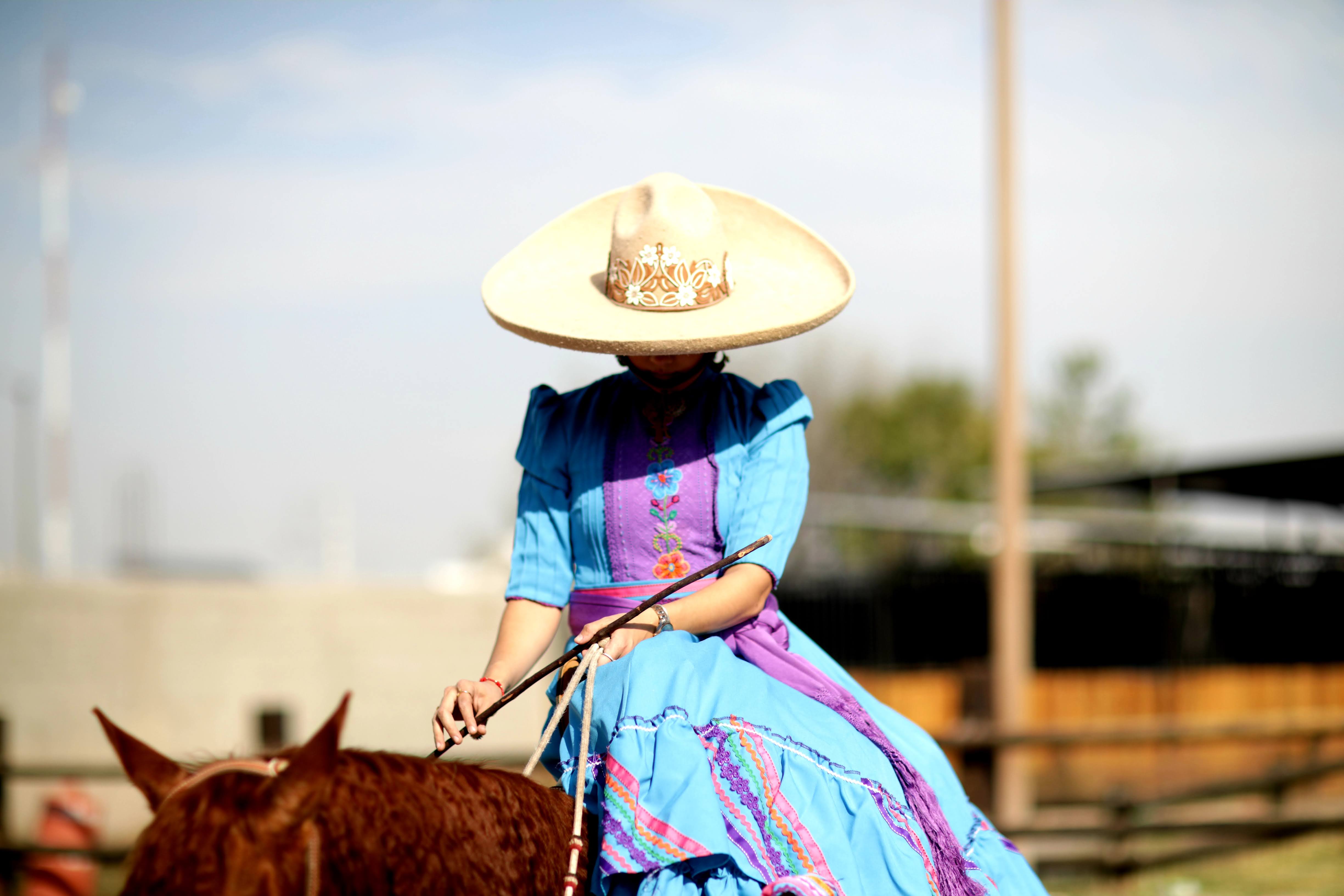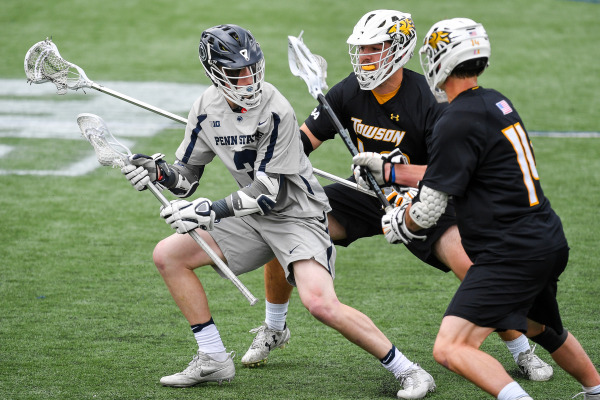- Name of sport (game): 5 Pin Bowling
- Name in native language: 5 Pin Bowling
- Place of practice (continent, state, nation):
Canada
- Description:
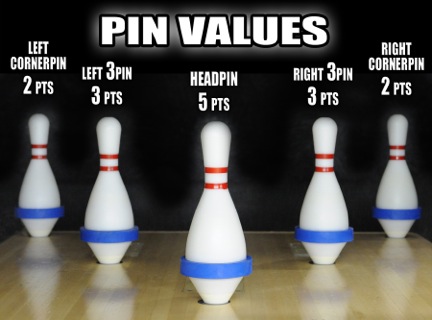
- Current status:
Practiced
- Contacts:
Canadian 5 Pin Bowlers´ Association
Web: http://www.c5pba.ca/index.php
Twitter: https://twitter.com/C5PBA
Youtube: https://www.youtube.com/user/C5PBA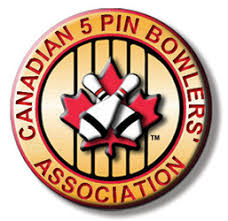
- Sources of information :
Articles:
https://web.archive.org/web/20151016201631/http://www.bowlcanada.ca/anniversary/chronologicalhistory.php
https://strikepointbowling.ca/5-pin-history/
https://youthbowl.ca/how-to-score/fivepin/
https://www.ontarioseniorgames.ca/pin-bowling/Video:
https://www.youtube.com/watch?v=9H2cjncHJsY&feature=emb_logo
https://www.youtube.com/watch?v=57DdLcsXvvI
https://www.youtube.com/watch?v=rdEIrdysVjs - Gallery:
- Documents:
- Name of sport (game): Carrera de Arihueta (Rohueliami)
- Name in native language: Carrera de Arihueta (Rohueliami)
- Place of practice (continent, state, nation):
Mexico. This activity is practiced by the Tarahumara ethnic group of Chihuahua. The race is authentically of Tarahumara origin, the elders say that it is as old as the ball race.
- Description:
Girls who are of school age practice this sport recreationally and run 4 to 8 kilometers. Adult women, experienced in the race, cover from 30 to 35 kilometers. When an event is of great importance to the group, an inter-city competition is scheduled, many people attend the event to support their team morally. It is not uncommon for people to bet. There is a wide variety of bets and it is not uncommon for people to buy blankets, pants, dresses, money, oxen, horses, goats, violins, corn and beans.
Each team has a hoop or circle to lift with a stick, and the competition begins when the runners have figured out the route and / or laps to be done on the track. Whoever misses the goal at the end first wins. The winning team collects its prizes (bets), which are then distributed among the winners.
Teams of 4 to 10 runners take part in the competition, and each participant must bring his own pole or stick. The team has two hoops, one is thrown and the other is reserved. The race starts when the hoop is thrown and everyone starts running. The hoop is thrown again by the runner who reaches the place where the first hoop fell and so on until it reaches the goal, it can be the whole team or just one person.
The material of the hoop is wood, fabric and wire. The hoop measures from 12 to 15 cm in diameter. The stick is made of wood, it must be straight, about 1.10 meters long. It is straightened, set on fire to heat it, and then the tip is bent to create a hook. Then he is ready to race.
- Current status:
Practiced
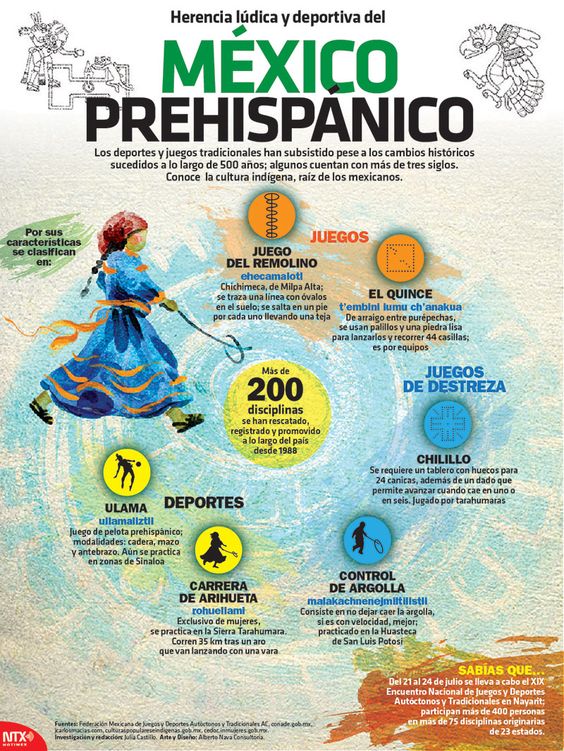
- Importance (for practitioners, communities etc.):
Among the variety of sports and recreational activities practiced by the Tarahumara, the Arihueta is a manifestation; exclusive of the female sex, with profound social impact.
- Sources of information :
Articles:
http://www.scielo.org.mx/scielo.php?script=sci_arttext&pid=S0185-06362005000100008
https://crayolafeliz.wixsite.com/tarahumaras/juego-de-la-arihueta
https://autoctonos2021.conade.gob.mx/arihueta.html
https://www.scielo.org.mx/scielo.php?script=sci_arttext&pid=S0185-06362005000100008
https://issuu.com/22ayuntamientoimdecuf/docs/libro/s/10765030Video:
https://www.youtube.com/watch?v=dM4hxBQsVvM
https://www.youtube.com/watch?v=cFQtlO-3npQ
https://www.youtube.com/watch?app=desktop&v=xP94kj-iMDUThe information contained in the article comes from the following sources:
Source of photos used in this article and gallery:
https://www.aplayfulpath.com/mexican-games-tocati-festival/carreradearihueta_fmjst/
https://revistalacampina.mx/tag/carrera-de-arihueta/
https://oaxaca.eluniversal.com.mx/estatal/04-08-2017/muestran-raramuris-en-oaxaca-sus-deportes-autoctonos
https://twitter.com/CONADE/status/893597636116312065
https://autoctonos2018.conade.gob.mx/disciplinas.html
https://chihuahua.gob.mx/prensa/inaugura-ichijuv-dos-espacios-conexion-joven-en-guachochi-con-inversion-de-200-mil-pesos
https://issuu.com/22ayuntamientoimdecuf/docs/libro/s/10765030 - Gallery:
- Name of sport (game): Carrera de Bola (Rarajipuami)
- Name in native language: Carrera de Bola (Rarajipuami)
- Place of practice (continent, state, nation):
la Sierra Tarahumara Estado de Chihuahua, Mexico
- History:
This sport is a tradition of the Tarahumara ethnic group that is passed down through the generations, practiced by children, adolescents and adults. People with "light feet" who run like the wind through the beautiful valleys, gorges and waterfalls of la Sierra Tarahumara Estado de Chihuahua. What made them internationally recognizable was the Carrera de la Bola.
- Description:
Carrera de Bola is a run for a wooden ball, which the athlets hit with their feet. First, however, the organizational measures of are necessary ("Chokeame") in order for the runners ("Júmame") to start their run.
Two teams compete, each with a ball made of "Comacali" wood, made of white oak (rosacame red), ash, root; strawberry tree (gurúbasi;) and tascate (camarí). Players must run the ball to the target by picking up the ball, throwing and kicking the ball. There are sometimes designated areas where the ball must not be touched with the hand, even if it has landed out of reach, in which case players use a stick or a branch.
Some Sierra races last up to two days. At night, the speed of runners is obviously slower than in races that last 5 to 20 hours.
Occasionally, there are bets with a code of honor - if a player bets on the peso, the opponent must do the same. Of course, money is used, but also a blanket, mirrors, threads and even animals.
The runners take part in the race individually or in teams, with up to 20 runners, although usually there are 3 to 6 runners.
The team that crosses the ball to the designated goal wins.
The races are organized all year round, mainly during the harvest season.Sometimes a night variant of Carrera de Bola is organized and it is played according to the same rules. The only difference is the presence of people accompanying the runners who light the path for the runner with a torch, which also helps when they need to search for the ball.
- Current status:
Practiced
- Sources of information :
Articles:
http://www.cronicadechihuahua.com/Primera-Carrera-de-Bola-Rarajipari,32373.html
https://clasico.difusionnorte.com/carrera-bola-raramuri/
https://elfistoldeldiablo.com/Publicacion.aspx?Post=4892018951723308473276
https://www.xataka.com.mx/otros-1/raramuris-los-indigenas-que-ganan-ultramaratones-porque-los-maratones-se-les-hacen-muy-cortos
https://ciudaddigna.org/2018/04/13190/
https://www.carreraspormontana.com/carreras/la-quixote-legend-contara-con-la-participacion-de-corredores-tarahumaras/Video:
https://www.youtube.com/watch?v=x4GVMYaHuMI
https://eu.elpasotimes.com/videos/news/local/2017/02/12/tarahumara-runners-take-part-'carrera-de-bola'/97833088/Sources of photos in article and gallery:
http://www.cronicadechihuahua.com/Primera-Carrera-de-Bola-Rarajipari,32373.html
https://clasico.difusionnorte.com/carrera-bola-raramuri/
https://www.xataka.com.mx/otros-1/raramuris-los-indigenas-que-ganan-ultramaratones-porque-los-maratones-se-les-hacen-muy-cortos
https://pl.pinterest.com/pin/104216178849589773/
http://www.jcarlosmacias.com/autoctonoytradicional/Deportes/Rarajipuami.html
https://elfistoldeldiablo.com/Publicacion.aspx?Post=4892018951723308473276
http://www.cronicadechihuahua.com/Anuncian-Encuentro-de-Juegos-y.html - Gallery:
- Name of sport (game): Charreria
- Name in native language: Charrería
- Place of practice (continent, state, nation):
Mexico
- History:
The subjugation of Mexico by the Spaniards meant a change in the way of life of the Meso-American peoples, as the conquerors brought with them new elements including firearms and horses.
In the second half of the 16th century and at the beginning of the 17th century, stock-breeding quickly developed in the territory of New Spain, and in the 17th century, it became an important element of the economy. In the second half of the 18th century, Mexican ranches became important centres both in the centre and in the north of the country. This development forced the use of horses for work, which over time led to the development of Mexican equestrian. As a consequence, it resulted in the need to organize horse breeding as livestock, as well as a service system, including systems for controlling this breeding, caring for animals and marking them. Cowboys, who marked the animals and shoed them with the right horseshoes, were responsible for most of this work. Often, these activities required the involvement of many people, which is why cowboys from other haciendas often came to help with these duties. The end of the joint work was an opportunity to celebrate and enjoy, hence these meetings sometimes transformed into large celebrations. At that time, they competed in horse riding, because participants were riders from other haciendas or ranches. Meetings and competition allowed to break with the monotony of everyday work. Various competitions were invented, such as capaderos (coleaderos), tusaderos and other types of horse competition.This is how the beginnings of Mexican charro looked like.In the 18th century, in a country with such a vast territory as Mexico, hacienda and ranches increased production, moreover, joint meetings, interrupting boredom with everyday work, became an important element of the life of the community, contributing to the creation of a common identity and the development of principles of coexistence in one society. This is how the charrería tradition was created.
At first, men used clothes and accessories that came from Spain, but over time Mexican riders began to shape new habits related to the practice of Mexican riding, as well as the daily work of hacienda. Clothes were sewn from solid cowhide leather or suede because this material is more resistant to damage. People started to wear breeches. There are also silver ornaments, which are a characteristic element of clothing even today. The term charro began to be used to designate this style.
The horse riding was shaped in the same way, acquiring originality and creating a peculiar riding tradition that has been passed down from generation to generation. A good example of this process is, for example, a Mexican saddle designed and constructed to be adapted to the specifics of cowboys' work in keeping cattle herds in order. Hence, there were such elements of saddle that allowed transport and use of long ropes (lasso), which cowboys used at work. Therefore, a different way of driving forced the use of unique solutions and differs from those used by the Spaniards (e.g. spurs or stirrups also have a different design). In addition, it should be noted that over time, traditional ornaments for decorating, as well as original fabrics, i.e. sarape, cincho and mantillas, made of materials and designs from different regions of the country began to be used.
At the end of the 19th century, during the historical period called Porfiriato (1877–1910), landowners extended their possessions while expanding the areas of animal husbandry. There were more and more workers dealing with cattle breeding, for whom the use of a horse in their work was very important. Among them were those who began to perform charras as a show, with a desire to make this their profession. The popularity of these shows allowed them to deal only with what they were paid for, just like travelling actors. These "commercial" performances concentrated mainly in cities, where cowboys showed their skills, acquired in everyday work in guarding cattle herds.
At the end of Porfiriato, the charro tradition ceased to exist. Horse racing, theaters, magazines and other "modern" entertainments were more popular. Charrería was close to oblivion, also due to the time of revolutionary armed struggle, when it was not practiced because of the conflict. At the end of 1921, after the end of the war, activities began to support the state in its efforts to return to Mexican customs, traditions and art. It is at this time that the National Association of Charros, A.C. is established, whose task was to create the statute and regulations that served as the basis for the organization of charrería throughout the country. The Nacional de Charros constitution meant the "revival" of the charro and charrería traditions.
From the 1920s and 1930s, the charro became one of the symbols of the Mexican image. There were, however, many misunderstandings between representatives of various charros, including those treating this custom as a commercial show, not related to the true charro tradition.
In 1933, President Abelardo L. Rodríguez institutionalize charrería as a "national sport".
"Charrería, Mexican Equestrian Tradition" was registered in the National Inventory of the Intangible Cultural Heritage of Mexico on March 4, 2014. This inventory is administered by the National Council for Culture and Arts and is available on the Cultural Information System website:
http://sic.conaculta.gob.mx/index.php?table=frpintangible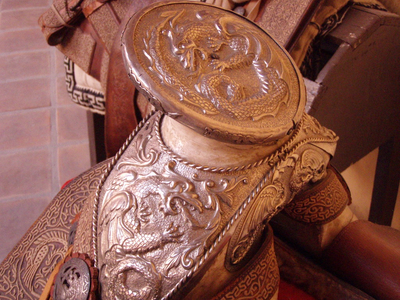
- Description:
There is a placed order of nine events that always start with the charros and escaramuzas horse parades.
The arenas where the charreadas take place are called “lienzos charros”. There are usually two separate areas that the lienzos take place: The first arena “manga or lienzo” is 66 yards (60 meters) by 13 yards (12 meters) and adjacent to the main arena (used for racing). The main arena called “ruedo” is round with a diameter of 44 yards (40 m) and here the main competition takes place there, the recent constructions have been totally covered in Ruedo and Lienzo, to allow the practice with special climatic environment (rain, high humidity) that make more difficult the use of the ropes.
Individual charros finish Suertes (10 particular tasks for male teams) in a specific order: cala de caballo, piales en el lienzo, colas, jineteo de toro, lazo de cabeza, pial de ruedo, jineteo de yegua, manganas a pie, manganas a caballo and paso de la muerte. Usually a group of charros from a specific city creates a team and accumulates points together, between six and 12 persons participate in each team. The points awarded in each Suerte depend on the technique of the person or team and the animal. A good charreada score is between 250 and 300 points, an excellent one scores more than 350 points. In the case of professional charrerias, there are three judges who announce the results of performances, in particular, Suerte by the microphone. Just as any sport, there are clearly defined rules for scoring points. For example, each person can participate in a maximum of three Suertes. Some parts of the competition are individual; others require teams consist of up to five players. Hundreds of charrería rules cover everything from animal assessment to charro skills.
Women teams are conformed by eigth persons, they have to follow a rutine of 12 specific movements in group, called “escaramuza charra”. The participation has to be done in less than eight minutes, and the results will depend on speed, technique, horse control, synchronization, and their equal uniform (charra or adelita suit) of the members of the team.
From 1933, charrería gained considerable popularity. When the Confederación Deportiva Mexicana was created, which initiated the establishment of the Federación Nacional de Charros. Then the organization adopted that the competition would consist of ten parts, or Suertes, which are played in the following order:
- Cala de Caballo - horse training show includes, among others gallop, trot, stopping the horse, turns, change of position walking forward and backward. Charro demonstrates his ability to control the horse at a gallop, stop on its hind legs and back. This competition requires extraordinary communication skills between horse and rider.
- Piales en el lienzo - a lasso grip on the horse's hind legs to stop him or slow down the race (not overthrow).
- Coleadero (Colas) - involves catching the bull's tail while running, putting your leg over the tail and knocking down the animal.
- Jineteo de Toros - the rider must stay on the bull's back as long as possible.
- Terna en el ruedo - demonstration of using the lasso while sitting on a horse. Two successful lasso (lazo de cabeza and pial de ruedo) throws should be made between the three charros: one with a loop around the head or horns and the other around the hind leg of the running cow so that it stays under the control of the thrower.
- Jineteo de Yeguas - staying on a brumby horse or bull until it stops.
- Manganas a pie - demonstration of using the lasso standing on the ground, then throwing the lasso on the horse's legs and stopping him. Causing a horse to fall is punished by a fine or suspension of the competitor.
- Manganas a caballo - demonstration of using the lasso when the rider is on a horse and in the last part casting the lasso on the forelegs of a speeding horse and stopping him.
- Paso de la muerte - changing a horse in a full run without using a saddle. The rider switches to another horse in full run and only keeps to the horse's mane until he stops.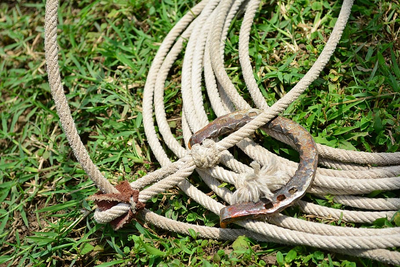
An important element of charrería is Escaramuza Charra, a set of exercises performed on a horse, accompanied by rancher music. Groups of at least 8 girls / or young women dressed in Mexican style, mount in a feminine style horse (on the side); they usually appear after colas and before jineteo. Young women, adelitas or charras, perform precise techniques at high speed, demonstrating courage, riding skills, teamwork and a feminine style of riding.
The real stars of the event are horses. Most of them are Aztec or Andalusian because charro requires a horse that is not too tall, but sufficient to be able to catch the bull and horse by the tail that is fast and strong enough to keep up with the bull. The horse must be calm enough to allow the use of a rope (lasso), but it must be agile and fast at the same time. The Mexican horse is bred as the ideal horse for charro.
Participants of Charra (Las charreadas) always start with a parade during which the group's banner is presented, accompanied by la “Marcha Zacatecas” (national charro hymn). Rancher music is also performed during the march.
At the end of Chorready (charreada), at least one pair of charro and the woman participating in the show is dancing Jarabe Tapatío, traditional Mexican dance.
The charro costume is recognized as a "national costume". It varies depending on the circumstances; the most commonly used costume is Faena, there are also Media Gala, Gala and Gran Gala costumes. Las escaramuzas (Escaramuza female participants) use the costumes of Rancher and de Charra, leaving China Poblana for special occasions.
Unlike the large national charrerías, smaller events that take place in Jaltemba Bay, for example, do not always contain all of the above, probably due to the smaller number of participants ( is just a brief example, not common).
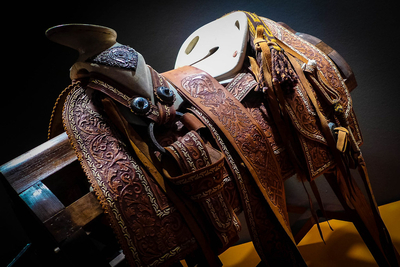
- Current status:
Charrería is one of the best known and most practiced sports in Mexico. It takes many different forms, from spontaneous and informal (usually in rural areas) to professionally organized in larger cities. Charrería is a great celebration of all those gathered: unique costumes, music, dance, tequila, beer and of course enormous emotions associated with the competition. Because whole families participate in this festival, the atmosphere is truly friendly. Charrería is not just a sport, it is a way to spend time together, build relationships and cultivate a Mexican identity. It is a living history resulting from experience, shared values and traditions.
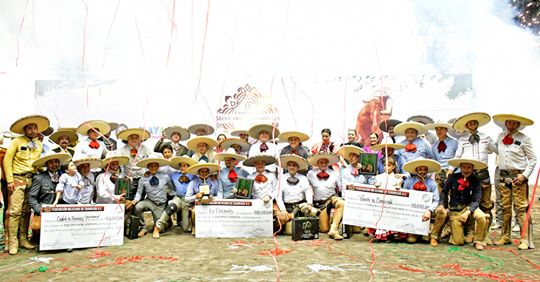 Concluyó el Campeonato Nacional Mexicano de Charrería 2019
Concluyó el Campeonato Nacional Mexicano de Charrería 2019 - Importance (for practitioners, communities etc.):
Charrería always treated the horse in a special way. In ancient times he was a companion in war, and often a valuable weapon because the very presence of riders caused the escape of the opponent. So the horse was not only for work. Charrería had a special influence on the way the horse was treated because it created a special relationship between the animal and the owner or master. Each horse has different personal characteristics and in Charrería it was noticed and appreciated. So the horse began to play an important role.
The image with which the Mexican is most often associated is charro. This image is identifiable worldwide and is considered typical of Mexico, despite the cultural and ethnic diversity that characterizes the Mexican nation.
Charro is, therefore, an element building identity rooted in the historical past.
Especially since family tradition in Mexico was usually built on three pillars: sport, culture and social relations. That is why in such a model of inheritance of tradition, charro has become an important element of social and family tradition. As a consequence, charro is also an important and lasting pillar of building a social and cultural identity in a new, constantly changing reality. Charro and charra are based on the ethical and moral values of the Mexican family, that is why this traditional sport is so important, understandable and close to Mexicans.The charreada event is complex and consists of many different elements of social and cultural significance: costumes, horses, sports skills, crafts as well as music, charro slang, sayings and specific language constructions. All this is the sum of long preparations, painstaking training sessions during which current generations share their knowledge with new ones, as it has been done from generation to generation for many years. Charreada is, therefore, a great place and a great opportunity to pass on traditions and values to new generations and all participants of the event.
On the other hand, one should not forget that charrería involves a significant number of representatives of various economic and social sectors: horse breeders and cattle breeders, producers of feed for horses and farm animals, carriers of horses and farm animals, veterinarians, blacksmiths, craftsmen of saddlery, equipment, textiles, embroideries, manufacturers of harnesses and other items for horses, music groups, traditional tailors, seamstresses, shoemakers and many other people.
The rules for de man and women competitions are stablished by the Federación Mexicana de Charrería, (National Federation of Charreria), this organization controls more than 1,300 associations, in the 32 states of Mexico and 13 states in the United States of America (Arizona, California, Colorado, Idaho, Illinois, Kansas, Nebraska, Nevada, New Mexico, Oklahoma, Oregon, Texas and Washington), enrolls more than 23,000 people, competing in different categories for both, male and female teams: 1) dientes de leche 2) infantil “A” 3) infantil “B” 4) juvenil 5) mayor and 6) libre, each category has every year its own National Championship, in the Free (Libre) Category, the annual enrollment for Mexico is 1,200 charro teams (male) and 750 escaramuzas teams (female), including EUA teams.
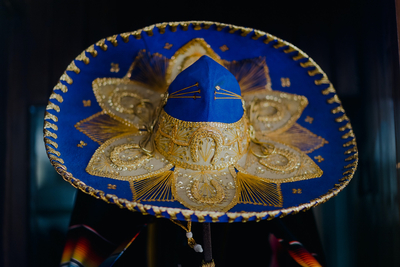
- Contacts:
Federación Mexicana de Charrería A.C.
E-mail:This email address is being protected from spambots. You need JavaScript enabled to view it.
Tel.: + 52 (55) 5709.4838
Fax: + 52 (55) 5709.4838
Isabel La Católica Nº 108,
colonia Centro Histórico
Delegación Cuauhtémoc,
C.P. 06080, Ciudad de México
Fb: https://www.facebook.com/fmcharreria/
Instagram: https://www.instagram.com/fmcharreria/
Twitter: https://twitter.com/fmcharreria/
Youtube: https://www.youtube.com/channel/UCFfV40wvFmADTlq3Pm2HYjA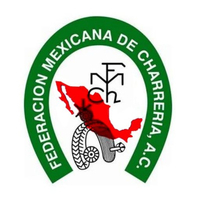
Asociación Nacional de Charros
Address: Av. Constituyentes 500, Col. Lomas Altas, México, D.F.
Telephone number: +52.55.14.23.16.67
E-mail:This email address is being protected from spambots. You need JavaScript enabled to view it. Asociación de Charros de Huichapan
Calle Francisco I. Madero SN, Barrio El Calvario, Huichapan, Estado de Hidalgo, México,
CP 42400
Boulevar Valle de San Javier No. 707 4º.piso,
Fraccionamiento Valle de San Javier Pachuca Hidalgo.
+52 771 7196649
E-mail:This email address is being protected from spambots. You need JavaScript enabled to view it. Asociación de Charros de Jalisco
Dr. R. Michel No.577A
Col. San Carlos
Espaldas del Parque Agua Azul,
Guadalajara, Jalisco, México
+52 33 36190315Asociación de Charros de Polotitlán
Zotitla No. 74 Col. Abdias García Soto Delegación Cuajimalpa México D.F. CP. 05583
+52 55 58122175
E-mail:This email address is being protected from spambots. You need JavaScript enabled to view it. Asociación de Charros Regionales de San Juan del Río
Vicente Rivapalacio No.12 CP 76800 Col.Centro
San Juan del Río Qro.
+52 427 488 2054
E-mail:This email address is being protected from spambots. You need JavaScript enabled to view it. Asociación de Charros de Morelia
Av.Camelias y Virrey de Mendoza s/numero
Col. Felix Ire
Morelia
Michoacán, CP.
+52 55 3333 6773
E-mail:This email address is being protected from spambots. You need JavaScript enabled to view it. Asociación de Charros de la Tuna Alta
Rancho la Tuna Alta, domicilio conocido Unión de San Antonio.
Jalisco, CP 68300
+52 395 7250 275
+52 477 7518 305Asociación de Charros de la Cuenca del Papaloapan
Lienzo Charro El Tutexpecano, domicilio conocido
San Juan Bautista Tuxtepec
Oaxaca de Juárez, CP 68300
+52 287 875 1229
+52 287 875 0859
E-mail:This email address is being protected from spambots. You need JavaScript enabled to view it. La Charreria en México - https://www.facebook.com/RAFAEL1JUAN
Charrería en Durango – https://www.facebook.com/Charrer%C3%ADa-en-Durango-1296780013768767/?eid=ARCPjYJf_MdjRa8zjJo9Wx6bol7fS63G9TbdKyS1gmA_RnqYYpECjOTVILlsXZ8uDo28_mpCKpxjRDcx
Escuela De Charreria Ruben Baez
+52 443 137 4432
https://www.facebook.com/escuelarubenbaez/Tradición Charra - https://www.facebook.com/tradicioncha/
Escuela de charreria "Mi Cuaco"
+52 55 4482 3297
Plaza Cívica de Santo Tomas Chiconautla
55069 Meksyk
https://www.facebook.com/Escuela-de-charreria-Mi-Cuaco-242717956113366/Escuela de Charreria de Hermanos Ortega
+52 477 670 3537
https://www.facebook.com/EscuelaDeCharreriaDeHermanosOrtega/Unión de Asociaciones de Charros del Estado de Jalisco - https://www.facebook.com/UAChEJ/
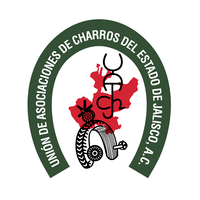
Unión de Asociaciones de charros del estado de Hidalgo - https://www.facebook.com/UCHARROSHIDALGO/
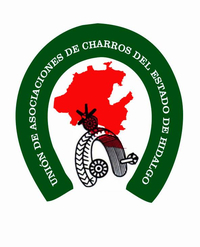
Unión de Asociaciones de Charros del Estado de México - https://www.facebook.com/pages/category/Esports-League/Uni%C3%B3n-de-Asociaciones-de-Charros-del-Estado-de-M%C3%A9xico-149474425208897/
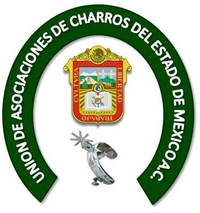
Muy Charro – https://www.facebook.com/muycharrotv/
+52 771 567 1875Charrería Mi Orgullo - https://www.facebook.com/oficialcharreriamiorgullo/
- Sources of information :
Biblioteca virtual Federación Mexicana de Charrería - https://www.fmcharreria.mx/?fbclid=IwAR0kylO17yFtdTvr9_5OnBqBS8_zvfBH5E91I_jZCu7i4D7KGhKatCT8u6Y
Books:
• Aguilar Rivera, José Antonio (2003) ‘Diatriba del mito nacionalista’, Revista Nexos núm. 309, septiembre. México, pp. 36-8.
• Alfaro, Alfonso (1994) ‘El tequila y sus signos: elogio del hidalgo campirano’, Artes de México, núm. 27, edición especial, México, noviembre-diciembre.
• Altamirano, Ignacio M. (1901) El Zarco. Ed. Porrúa, 22ª. Ed., Col. Sepan Cuantos, núm. 61, México.
• Álvarez del Villar, J. (1968) Orígenes del charro mexicano. México: Librería A. Pola.
• Álvarez del Villar, J. (1981) Hombres y caballos de México: historia y práctica de la charrería. México, D.F.
• Álvarez del Villar, J. (1987) La charrería mexicana: su historia y práctica. México D.F.: Panorama Editorial.
• Ancona, George (1999) Charro. The Mexican Cowboy. San Diego, New York, London: Harcourt Brace and Company.
• anders, Karen (1997) Nación y tradición. Cinco discursos en torno a la nación peruana 1885-1930. México: FCE.
• Anderson, Benedict (1993) Comunidades imaginadas. México: FCE.
• Angel, Alberto (1997) ‘El Cuervo’, ‘Con M de México’, Charrería. Patria y Tradición. No. 33, Vol. IV, México.
• Appadurai, Arjun (1996) Modernity at Large: Cultural Dimensions of Globalization, Public Works. Vol. 1. U. de Minnesota Press. Minneapolis y London.
• arba Franco, Felipe y Pilar (1989) Don Andrés Z. Barba. Cien años, una herencia. Impreso en Guadalajara, mayo, pp. 63-4.
• Arena Vallarta. (2016). El charro en la era moderna. Recuperado el 18 de junio de 2017, de Arena Vallarta: http://arenavallarta.com
• Ballesteros, José Ramón (1972) Origen y evolución del charro mexicano. Manuel Porrúa, México. B
• Barba López, F. (27 de julio de 2017). Charro del municipio de Bahía de Banderas, Nayarit. (J. A. López Sánchez, Entrevistador)
• Barragán López, Esteban (1997) Con un pie en el estribo. Formación y deslizamientos de las sociedades rancheras en la construcción del México moderno. Zamora: Colegio de Michoacán.
• Barragán López, Esteban; Hoffmann, Odile et al (Coord) (1994) Rancheros y sociedades rancheras. CEMCA, El Colegio de Michoacán, ORSTOM, México.
• Bartra, Roger (1987) La jaula de la melancolía. Identidad y metamorfosis del mexicano. México: Grijalbo.
• Bartra, Roger (2002) ‘Crónica de un nacionalismo inventado. La condición posmexicana’, Nueva Revista de política, cultura y arte, No. 81, mayo-junio, Madrid, pp. 21-6.
• Béjar Navarro, Raúl (1968) El mito del mexicano. México: UNAM.
• Bello Villegas, Coty (1993) ‘Las escaramuzas’, Revista Escaramuza, septiembre. Tamaulipas, México: Producciones Sagitario, Cd. Victoria.
• Bonfil Batalla, Guillermo (1987) El México profundo. México: SEP/Ciesas.
• Brading, David (1982) Los orígenes del nacionalismo mexicano. México, Era.
• Brod and Kaufman (comps.) (1994) Theorizing masculinities. London: Sage Publications.
• Carlos Rincón Gallardo, El Libro del Charro Mexicano, 3rd ed. México, D.F.: Editorial Porrúa SA, 1960
• Carreño King, Tania (2000) ‘El charro’. La construcción de un estereotipo nacional (1920-1940). Ed. Instituto Nacional de Estudios Históricos de la Revolución Mexicana y Federación Mexicana de Charrería, A.C., México.
• Carreño King, Tania (2000) ‘Yo soy mexicano, mi tierra es bravía’, Artes de México, Revista Libro sobre Charrería, número 50, México.
• Chávez Gómez , O. (2014). La charrería brevario del deporte nacional.(Primera ed.). México: Consejo Editorial de la Administración Pública Estatal. C
• Chávez, Martha (1998) Mujeres de rancho, de metate y de corral. Zamora: El Colegio de Michoacán.
• Chávez, Octavio (1993) La charrería: tradición mexicana. México: Ed. Casa Pedro Domecq.
• Cohen, Anthony P. (1993) The symbolic Construction of Community. London: Routledge.
• Corrales Ramírez, I. G. (15 de julio de 2017). Escaramuza Las Alazanas de Bucerías. (J. A. López Sánchez, Entrevistador)
• Cuéllar, Alfredo B. (1928) Charrerías. México: Imprenta Azteca.
• CULTURA. (13 de septiembre de 2017). Secretaría de Cultura. Recuperado el 25 de enero de 2019, de Declaran a la charrería como Patrimonio Cultural de la Humanidad: https://www.gob.mx/
• Dalevuelta, Jacobo (seud.) (1932) El charro símbolo. Edición particular, propiedad artística y literaria de F. Ramírez de Aguilar, México.
• Díaz Arcienega, Víctor (1982) Querella por la cultura revolucionaria (1925. México: FCE.
• Díaz Ugalde , L. (07 de septiembre de 2014). Traje de charro, una obra de arte de orgullo nacional. Recuperado el 23 de julio de 2017, de http://www.informador.com.mx/
• Díaz y Ovando, Clementina (1999) ‘Las fiestas del “Año del Centenario”, 1921’. En Patricia Galeana (coord.) El nacimiento de México. México: FCE y Archivo General de la Nación.
• Doñan, Juan José (2000) ‘Por mi raza hablará Jorge Negrete’, Artes de México, Revista Libro sobre Charrería, número 50, México.
• Florescano, Enrique (1987) Memoria mexicana. México: FCE.
• Florescano, Enrique (1996) Etnia, Estado y Nación. México: Ed. Taurus.
• Florescano, Enrique (2002) Historia de las historias de la nación mexicana. México: Ed. Taurus.
• FMCH. (2016). Federación Mexicana de Charrería, A.C. Obtenido de Reglamento escaramuzas y damas charras.
• FMCH. (2017). Federación Mexicana de Charrería, A.C. Obtenido de Reglamento de competencias categoría infantil dientes de leche, categoría infantil "A", categoría infantil "B" y charros mayores 2017-2020.
• G. de Cerón, O. (03 de agosto de 2014). Charrería, la más hermosa y mexicana de las fiestas y orgullo de nuestra nación. Recuperado el 19 de junio de 2017, de http://www.azteca21.com
• G. de Cerón, Oralia Isabel (2002) ‘Charrería: herencia de valores’, Art of the Charrería. A Mexican Tradition. Los Angeles: Autry Museum of Western Heritage, p. 31.
• G. de Cerón, Oralia Isabel (2002) ‘La charrería arte: su historia y sus artesanos’, Art of the Charrería. A Mexican Tradition. Los Angeles: Autry Museum of Western Heritage, pp. 22-8.
• Gallegos Franco, Francisco (1996) Así es Tepatitlán (tradiciones y sucesos). Tepatitlán: Consejo de Cronistas de Tepatitlán de Morelos.
• García Oropeza, Guillermo (2002) ‘Zapopan hoy’, Artes de México núm. 60, Zapopan. Edición especial, México.
• Gauchet, Marcel; Pierre Manent y Pierre Rosanvallon (dir.) (1997) Nación y modernidad. Buenos Aires: Ed. Nueva Visión.
• Gojman de Backal, Alicia (2000) Camisas, escudos y desfiles militares. Los Dorados y el antisemitismo en México (1934-1940). México: FCE.
• González y González, Luis (1968) Pueblo en vilo. Fondo de Cultura Económica, México.
• Gómez Encarnación, E. (2007). Al trochi mochi... El habla cotidiana de los pueblos del Valle de Banderas hasta 1960. Puerto Vallarta: CONACULTA.
• Gutiérrez, Natividad (2000) ‘Mujeres, patria-nación. México: 1810-1920’, Revista de estudios de género. La ventana. Núm. 12, Vol. II, Universidad de Guadalajara, Guadalajara, diciembre.
• Hobsbawm, Eric y Terence Ranger (1984) The Invention of Tradition. Cambridge: Cambridge Press.
• IDET. (2011). Instituto del deporte de Tlaxcala. Recuperado el 02 de mayo de 2017, de Historia de la charrería: https://idet.tlaxcala.gob.mx/
• INAH. (01 de diciembre de 2016). Instituto Nacional de Antropología e Historia. Recuperado el 20 de febrero de 2017, de La charrería, tradición ecuestre en México: http://www.inah.gob.mx/es/boletines/5783-reconoce-la-unesco-a-la-charreriatradicion-ecuestre-en-mexico-como-patrimonio-cultural-lnmaterial-de-la-humanidad México desconocido. (2017). Historia de la charrería en México. Recuperado el 20 de febrero de 2017, de https://www.mexicodesconocido.com.mx/
• Inclán, Luis G. (1860) Recuerdos del Chamberín. México.
• Inclán, Luis G. (1860) Reglas con que un colegial puede colear y lazar. México.
• Inclán, Luis G. (1872) El capeadero en la Hacienda de Ayala. México.
• Inclán, Luis G. (1940) El libro de las charrerías, ed., y prólogo de Manuel Toussaint. México: Librería de Porrúa hnos.
• Inclán, Luis G. (1987 [1865]) Astucia: el jefe de los hermanos de la hoja o los charros contrabandistas de la rama. Ed. Porrúa, México, Primera ed.
• Islas Escárcega, Leovigildo (1967) ‘Síntesis histórica de la charrería’, Artes de México, núm. 99, año XIV, 2ª Epoca.
• Jáuregui, Jesús (1990) El mariachi. Símbolo musical de México. México: INAH/Banpaís.
• José Lepe, Diccionario Enciclopédico sobre Asuntos Ecuestres e Hípicos, México, D.F.: Editorial Porrúa SA, 1972
• José Valero Silva, El Libro de la Charrería, México, D.F.: Banco BCH, S.N.C, 1985
• Kaplan, Caren; Norma Alarcón y Minoo Moallem (eds) (1999) Between Woman and Nation. Nationalisms, Transnational Feminisms, and the State. Durham y London: Duke University Press.
• Kathleen Mullen Sands, Charrería Mexicana, Tuscon: the University of Arizona Press, 1993
• Leovigildo Islas Escárcega, Historical Synthesis of Charrería, El arte de la charrería, 99 (1967), 19-21
• Leovigildo Islas Escárcega, Rodolfo García Bravo y Olivera, Diccionario y Refranero Charro, México, D.F.: Edamex, 1992
• Lomnitz, Claudio (1995) Las salidas del laberinto. México: Ed. Joaquín Mortiz-Planeta.
• Lomnitz, Claudio (2001) Deep México, Silent México. An Anthropology of Nationalism. Minneapolis y London: University of Minnesota Press.
• Lomnitz, Claudio (2003) ‘Times of Crises: Historicity, Sacrifice, and the Spectacle of Debacle in Mexico City’, Public Culture 15 (1) pp. 127-47. Duke University Press.
• López Victoria, José Manuel (1965) La Campaña Nacionalista. México: Botas.
• María Herrera-Sobek Celebrating Latino Folklore: An Encyclopedia of Cultural Traditions, Volum 1 A-D, ABC-CLIO, 2012
• McClintock, Anne; Aamir Mufti y Ella Shohat (eds) (2002) Dangerous Liaisons. Gender, Nation, and Postcolonial Perspectives. Minneapolis y London: University of Minnesota Press.
• Mexico: Secretaría de Cultura, Gobierno del Estado de Jalisco, 2004
• Meyer, Jean (1991) ‘Perspectives de l’analyse socio-historique de l’influence de Guadalajara sur sa région’, citado por Ramón María Serrera. Guadalajara ganadera. Estudio regional novohispano (1760-1805). Ediciones del Ayuntamiento de Guadalajara, Guadalajara 450 años.
• Miller, David (1995) Sobre la nacionalidad. Barcelona: Ed. Paidós.
• Molina, Daniel (2002) Milonga para el macho triste. Entrevista con Jorge Salessi. Suplemento Cultura y Nación, El Clarín, Buenos Aires, 15-VI-02.
• Monsiváis, Carlos (1976) ‘Cultura nacional y cultura colonial en la literatura mexicana’, Características de la cultura nacional. México: ISUNAM.
• Monsiváis, Carlos (1976) ‘La cultura mexicana en el siglo XX’. En Contemporary Mexico; papers of the IV International Congress of Mexican History, James W. Wilkie et al. (eds) Estados Unidos: University of Califoria Press.
• Monsiváis, Carlos (1976) ‘Notas sobre la cultura mexicana en el siglo XX’, Historia General de México. México: Colmex.
• Monsiváis, Carlos (1985) ‘De algunos problemas del término “cultura nacional” en México’, Revista Occidental, año 2, núm. 1.
• Mosse, George L. (1985) Nationalism and Sexuality. Respectability and Abnormal Sexuality in Modern Europe. New York: Howard Fertig.
• Mosse, George L. (1996) The Image of Man. The Creation of Modern Masculinity. Oxford: Oxford Press.
• Mullen Sands, Kathleen (1993) Charrería Mexicana. An Equestrian Folk Tradition. Tucson y London: The University of Arizona Press.
• Muriá, José María; Cándido Galván y Angélica Peregrina (comp.) (1987) Jalisco en la conciencia nacional. Tomo I. México: Ed. Gobierno del Estado de Jalisco e Instituto de Investigaciones Dr. José María Luis Mora.
• Nájera-Ramírez, Olga (2002) ‘La charreada en los Estados Unidos’, Art of the Charrería. A Mexican Tradition. Los Angeles: Autry Museum of Western Heritage.
• Noriega Elio, Cecilia (comp.) (1994) El nacionalismo en México. Zamora: Col. De Michoacán.
• Octavio Chávez, La Carreria: Tradición Mexicana, 2nd ed. México, D.F.: Casa Pedro Doecq, 1993
• ODEME. (03 de noviembre de 2017). Confederación Deportiva Mexicana, A.C. Recuperado el 25 de Enero de 2019, de Federación Mexicana de Charrería, A.C.: http://www.codeme.com.mx/
• Olga Nájera-Ramírez, Engendering Nationalism: Identity, Discourse, and the Mexican Carro, Anthropological Quarterly 67.1 (1994), 1-14
• Olveda, Jaime (1987) ‘La política de Jalisco durante la primera época federal’. En José María Muriá; Cándido Galván y Angélica Peregrina (comp.) Jalisco en la conciencia nacional, Tomo I. México: Ed. Gobierno del Estado de Jalisco e Instituto de Investigaciones Dr. José María Luis Mora, pp. 292 y sigs.
• Ortiz Macedo, Luis (1995) Ernesto Icaza: El charro pintor. Domecq y Miguel Angel. México: Porrua.
• Pacheco, José Emilio, et al. (1989) En torno a la cultura nacional. México: Dirección General de Publicaciones del CNCA/Instituto Nacional Indigenista.
• Palomar, Cristina (2000) ‘La charrería en el imaginario nacional’, Artes de México, Revista Libro sobre Charrería, número 50, México.
• Palomar, Cristina (2000) ‘Patria, mujer y caballo’, Artes de México, Revista Libro sobre Charrería, número 50, México.
• Palomar, Cristina (2002) El orden discursivo de género en Los Altos de Jalisco. Tesis doctoral, inédita.
• Palomar, Cristina (2003) En cada charro un hermano: la charrería en el estado de Jalisco. México: Secretaría de Cultura del estado de Jalisco, en prensa.
• Parker, Andrew; Mary Russo, Doris Sommer y Patricia Yaeger (eds) (1992) Nationalisms and Sexualities. New York y London: Routledge.
• Paz, Octavio (1964) El laberinto de la soledad. México: FCE.
• Paz, Octavio (1974) Las peras del olmo. Barcelona: Seix Barral.
• Paz, Octavio (1982) ‘ “Re/visiones: la pintura mural” en México en la obra de Octavio Paz. T. III’, Los privilegios de la vista. México: FCE, 1987.
• Pérez Montfort, R. (2011). Nacionalismo y representación en el México posrevolucionario (1920-1940). La construcción de estereotipos nacionales. En P. Escalante Gonzalbo, La idea de nuestro patrimonio histórico y cultural (págs. 247- 269). México: CONACULTA.
• Pérez Montfort, Ricardo (1988) Por la patria y por la raza. El discurso nacionalista de la derecha secular durante el sexenio del general Lázaro Cárdenas. México: Facultad de Filosofía y Letras/Unam, tesis de maestría.
• Pérez Montfort, Ricardo (1990) ‘Nacionalismo y estereotipos 1920-1940’, El Nacional Dominical, núm. 25, año 1, México, 11 de noviembre.
• Pérez Montfort, Ricardo (1992) Hispanismo y Falange: los sueños imperiales de la derecha española y México. México: FCE.
• Pérez Montfort, Ricardo (1994) Estampas del nacionalismo popular mexicano. Ensayos sobre cultura popular y nacionalismo. México: Ciesas.
• Peterson Royce, Anya (1982) Ethnic Identity. Strategies of Diversity. Bloomington: Indiana University Press.
• Prado, Bayardi (1995) ‘Don Filemón Lepe’, Charrería, Patria y Tradición. No. 17, Vol. 111, México.
• RAE. (2017). Real Academia Española. Recuperado el 25 de julio de 2017, de Diccionario de la lengua española: http://dle.rae.es/?w=diccionario
• Rai, Shirin M. (2002) Gender and the Political Economy of Development. Cambridge: Polity Press.
• Ramírez Gil, R. A. (2013). El deporte la charrería en Bahía de Banderas, Nayarit. Nuevo Vallarta, Nayarit: Universidad Tecnológica de Bahía de Banderas.
• Ramírez Villalvazo, R. (10 de junio de 2017). Asociación de Charros Regionales de Nayarit, A.C. (J. A. López Sánchez, Entrevistador)
• Ramírez, Ana Cristina (2000) La charrería. Tradición inventada y comunidad imaginada. Ensayo inédito. CEA-Colmich, Marzo.
• Ramírez, Ana Cristina (2001) El juego del valor. La participación femenil en la charrería. Tesis de maestría, Colmich: CEA, septiembre.
• Ramos, Samuel (1994 [1934]) El perfil del hombre y la cultura en México. México: El Colegio Nacional-Espasa Calpe Mexicana.
• Rincón Gallardo, Carlos (1939) El charro mexicano. México: Porrúa,.
• Roberto Islas Carmona, The Charro’s Apparel, El arte de la charrería, 99 (1967), 26-38
• Rodríguez Acevedo, J. (14 de septiembre de 2011). 14 de septiembre día del charro. Recuperado el 18 de junio de 2017, de http://ntrzacatecas.com/
• Sánchez Hernández, Guillermina (1993) La charrería en México. Ensayo histórico. Guadalajara: INAH y Secretaría de cultura del estado de Jalisco.
• Sánchez Lira, Rafael (1956) Iluminación nacionalista. México: Luz. S
• Schmidt, Henry C. (1978) The Roots of ‘lo mexicano’. Self and Society in Mexican Thought, 1900-1943. College Station y London: Texas A&M University Press.
• Serrano Álvarez, Pablo (1992) La batalla del espíritu. El movimiento sinarquista en el Bajío (1932- 1951). México: Conaculta.
• Serrera, Ramón María (1991) Guadalajara ganadera. Estudio regional novohispano (1760-1805). Ed. Del Ayuntamiento de Guadalajara, Guadalajara 450 años.
• SIAP. (09 de agosto de 2017). Servicio de Información Agroalimentaria y Pesquera. Recuperado el 27 de enero de 2019, de Yunta: ¿de mulas o de bueyes?: https://www.gob.mx/siap/articulos/yunta-de-mulas-o-debueyes?fbclid=IwAR0NsSEEkAdInX5yPxdrv7ZoZMO5ijTjwzm0q7pR3HRFrtYlPSO3 dUbFn9U
• SRE. (01 de abril de 2013). Secretaría de Relaciones Exteriores. Recuperado el 20 de febrero de 2017, de Charrería mexicana, deporte nacional por excelencia: https://embamex.sre.gob.mx/
• Tenorio Trillo, Mauricio (1998) Artilugio de la nación mexicana. México en las exposiciones universales, 1880-1930. México: FCE.
• Torres Jiménez, A. J. (29 de julio de 2017). Charro del municipio de Bahía de Banderas, Nayarit. (J. A. López Sánchez, Entrevistador)
• Turner, Frederick C. (1971) La dinámica del nacionalismo mexicano. México: Grijalbo.
• UNESCO. (2016). Patrimonio Cultural Inmaterial de la Humanidad. Recuperado el 2017 de julio de 19, de La charrería, arte ecuestre y vaquero tradicional de México: https://ich.unesco.org/
• Valero Silva, José (1987) El libro de la charrería. México: Gacela.
• Vasconcelos, José (1950) Discursos 1920-1950. México: Botas.
• Vázquez de Knauth, Josefina (1970) Nacionalismo y educación en México. México: Colmex.
• Verea, Cristina Palomar. En cada charro, un hermano: la charrería en el estado de Jalisco. Jalisco,
• Zuno, José Guadalupe (1957) Las artes populares en Jalisco. Guadalajara: Centro Bohemio.Articles:
https://www.puertovallarta.net/fast_facts/la-charreria-the-charro-mexico-01
https://ich.unesco.org/en/RL/charreria-equestrian-tradition-in-mexico-01108
https://ontheroadin.com/mexican-charreria/
https://theculturetrip.com/north-america/mexico/articles/a-guide-to-charreria-mexicos-national-sport/
https://www.gob.mx/sectur/articulos/la-charreria-mexicana-patrimonio-inmaterial-de-la-humanidad-unesco
https://www.chapala.com/chapala/magnifecentmexico/charreria/charreria.html
https://www.lucchese.com/thelastword/2017/11/3/charreria-the-mexican-sport/Video:
Cala de Caballo - https://www.youtube.com/watch?v=A0VopN4jccQ
Piales - https://www.youtube.com/watch?v=JDppztY2-LM
Coleadero - https://www.youtube.com/watch?v=pCoZvBttdSo
Jineteo de Toros - https://www.youtube.com/watch?v=2dSR1pYuaX4
Terna en el ruedo - https://www.youtube.com/watch?v=b9gJJKXFZOk
Jineteo de Yeguas - https://www.youtube.com/watch?v=eDIt48e0jZ0
Manganas a pie - https://www.youtube.com/watch?v=o2V6pWdPT9g
Manganas a caballo - https://www.youtube.com/watch?v=DHO7FKnOgAI
Paso de la muerte - https://www.youtube.com/watch?v=sf5s3Qqt48IThe information contained in the article comes from the following sources:
http://sic.conaculta.gob.mx/index.php?table=frpintangible
Biblioteca virtual Federación Mexicana de Charrería - https://www.fmcharreria.mx/?fbclid=IwAR0kylO17yFtdTvr9_5OnBqBS8_zvfBH5E91I_jZCu7i4D7KGhKatCT8u6Y
https://www.puertovallarta.net/fast_facts/la-charreria-the-charro-mexico-01
https://ich.unesco.org/en/RL/charreria-equestrian-tradition-in-mexico-01108
https://ontheroadin.com/mexican-charreria/
https://theculturetrip.com/north-america/mexico/articles/a-guide-to-charreria-mexicos-national-sport/
https://www.gob.mx/sectur/articulos/la-charreria-mexicana-patrimonio-inmaterial-de-la-humanidad-unesco
https://www.chapala.com/chapala/magnifecentmexico/charreria/charreria.html
https://www.lucchese.com/thelastword/2017/11/3/charreria-the-mexican-sport/Source of photos used in this article and gallery:
https://museodelacharreria.org.mx/en/
https://grupoandares.com/tour/tour-charreria/
https://www.gdltours.com/Mexican.Rodeo/
https://www.pikipikioverland.com/charreria-mexican-horsemanship/
https://www.gob.mx/sectur/articulos/la-charreria-mexicana-patrimonio-inmaterial-de-la-humanidad-unesco
https://mextrotter.com/en/lexikon/charreria/
https://www.gob.mx/cultura/articulos/la-charreria-es-ya-patrimonio-cultural-inmaterial-de-la-humanidad
https://www.pexels.com/photo/charreria-18423228/
https://elsouvenir.com/la-charreria-patrimonio-inmaterial-mexico/
https://museodelacharreria.org.mx/en/
https://www.aztecas.eu/meksyk/historia/charreria/
https://visitguadalajara.com/sports
https://www.elsoldelcentro.com.mx/deportes/la-charreria-deporte-nacional-por-excelencia-11181374.html
https://apimagesblog.com/blog/2015/03/13/mexican-rodeo-keeps-ranch-traditions-alive - Gallery:
- Documents:
- Name of sport (game): Chupa Porrazo (Xhupa Porrazo)
- Name in native language: Caída de Dos
- Place of practice (continent, state, nation):
The State of Oaxaca (the Isthmus of Tehuantepec), practiced by Zapotecs, Mexico
- History:
Chupa Porrazo, which in Zapotec means “two blows” or “two falls”, taking the variant of Zapotec from the Isthmus of Tehuantepec, where “sucks” is “two”. The "blow" is understood as a fall or a blow. "Porrazo", however, is not a Zapotec word, but comes from Spanish. What does exist in Zapotec is the word "porra" which means knot, which can give a similarity to the keys or padlocks used in the fight.
The origins of the Chupa Porrazo date, according to Adrián Romero Díaz, from 300 BC, a date close to the peak of the splendor of the Zapotec culture. There is even visual evidence in engravings found in the ruins of Monte Albán.
- Description:
The Chupa Porrazo is based on the imitation of movements of seven animals with which there is a physical and spiritual connection. The animals are the snake (bandage), the eagle (biphia), the ocelot (peye), the monkey (migu), the deer (biguina), the iguana (buxhashi) and the armadillo (gupi).
The opponents face each other, wearing only short pants, and take hold of the belt or strap that they wear at the waist.This is done, a kind of dance begins in which each one tries to unbalance his opponent. When any of the fighters manages to unbalance the opponent, based on the weight, they execute a sacrifice turn and then fall backwards and, at the same time, place one foot on the opponent's abdomen, pulling him towards himself, thus making the other fly. over it and fall backwards. But this is not the only technique; In the practical application, the sucker blow fighter uses any support in the opponent's body (arms, waist or even the feet) to throw himself to the ground.
The fight between two people, placed face to face, who to start the fight take hold of the girdle that they have fastened at the waist, force is used to try to unbalance the opponent, knocking him down; and doing it; touch the floor with the back, at this time the match ends, winning the one who achieved this; It is not allowed to use the legs to unbalance the opponent. For your practice; an open space with loose soil is required.
Weapons are also assimilated, which over time were modified or replaced. We have the nayula, which is like a machete; the ichi-short, which is a pointed spear, the long-needle, a normal spear; the guiche, a sling; the dova, a rope; the gulliu, a knife; the ille wound, a stone-tipped stick and the ille, the boleadoras.
- Current status:
The practice of Chupa Porrazo finds its origin in the Isthmus of Tehuantepec, in Oaxaca, where four neighborhoods practice it: Juchitán, Ixtepec, Tehuantepec and Ixtaltepec. Tournaments are held within communities, involving both young and old.
The Chupa Porrazo practiced by children is called Chechite Nu.
- Sources of information :
Article:
https://matadornetwork.com/es/olvidate-del-karate-y-aprende-todo-sobre-el-xhupa-porrazo-mexicano/Video:
https://www.youtube.com/watch?v=LXS4pWwM2JISource of photo in article and gallery
http://smastreetmarcialarts.blogspot.com/2012/04/el-chupa-porrazo.html
- Name of sport (game): Escaramuza charra
- Place of practice (continent, state, nation):
Mexico
- Sources of information :
photos by Guillaume Lanouhe
- Gallery:
- Name of sport (game): Lacrosse, coined by a French jesuit Jean de Brébeuf
- Name in native language: dehuntshigwa’es (in Onondaga language means “men hit a rounded object”), da-nah-wah’uwsdi (in Eastern Cherokee language means “little war”), Tewaarathon (in Mohawk language “little brother of war”).
- Place of practice (continent, state, nation):
Lacrosse is popular in the whole world, especially in Canada and USA. Also, often it is practiced in UK and Australia, less often in New Zealand, Japan and South Korea.
- History:
Lacrosse has its roots in America. The game itself was invented by Indians, who, in the beginning, did not define the boundaries of the playing field and places of goal (the role of goal played trees and boulders). Number of players in teams varied from 100 to 1000, including members from different tribes. While playing players used two sticks, which looked like they was riding horses. The ball was made from reindeer skin.
In Europe lacrosse came after 1636, when a French jesuit Jean de Brébeuf, while being in America, was watching Iroquois tribe playing game and later described the basic concept of game in Europe. However, modern rules that are played nowadays was introduced only in 1856, when a Canadian dentist George Beers established the first lacrosse club “Montreal Lacrosse Club”, shorting the play time and limiting the number of players to 10 people.
Nevertheless, the popularity of lacrosse grew only in the beginning of XX century, because it was an Olympic discipline during the Olympic Games in 1904 and 1908. Later, approximately in 30s, the second version of the game playing indoor began to widespread. - Description:
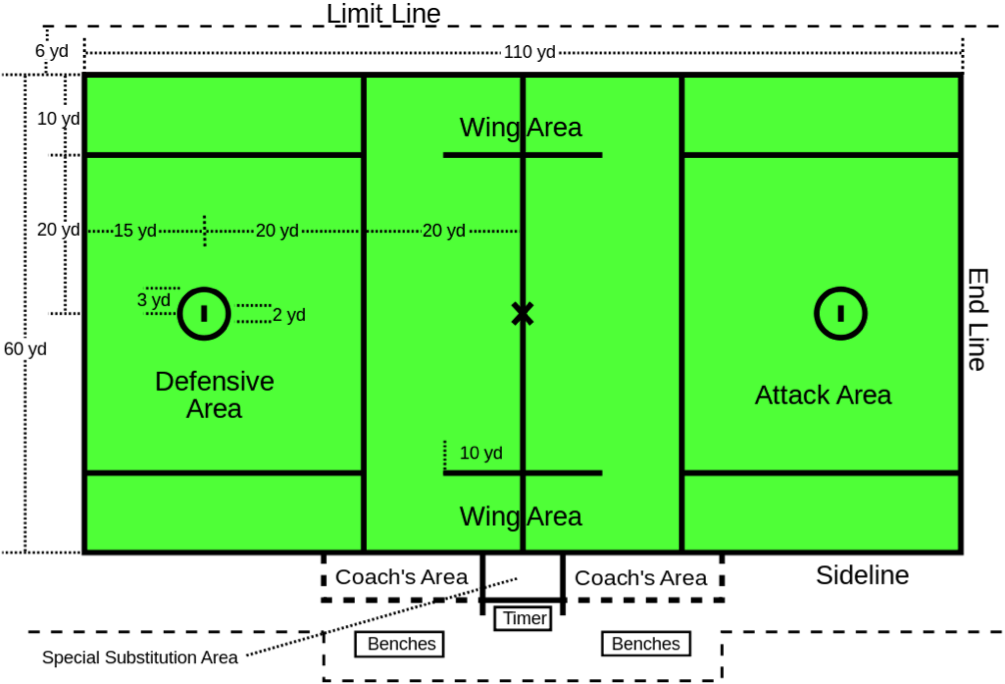
Rules are regulated by the Federation of International Lacrosse (FIL), the international governing body for men’s and women’s lacrosse. Clashes between players are allowed, as well as bumping each other involving the sticks. Each of the quart starts from well-known hokey game-play face-off, which means that the referee drops the ball between two opposing players. The same action is after the each goal scored.
The playing time for the match is 60 minutes and is divided into 4 periods of 15-minutes quarters. For scoring the player have to shoot the gam ball, , which can be either of yellow, orange or white colour into the goal of the opposite team. The weight of ball is appox. 150 gram and is 20 cm in a circle.
The lacrosse stickLacrosse has two types of penalties. For personal fault, for example hitting the opposer below the waist, unsportsmanlike behavior or improperly built sports equipment, the player is sent to the penalty bench. If it is a technical foul (e.g. crushes, restraining the opposer or keeping the ball), it is likely to end up with the restrictive punishment.
There are two variations of playing the lacrosse:
a) Outdoor or field lacrosse
Each team has 10 players and consists of 3 attack-men, 3 midfielders, 3 defensemen, and 1 goalie (or goaltender). Players can use two types of sticks: “short crosse” (ca. 1 meter long) or “long crosse” (ca. 1,5 meter long). The goaltender can choose the stick between 1 meter long and 1,5 meter long. However, it is not allowed to use 4 long sticks at the same time while playing on the field. Players always wear protective equipment such as helmets, a pair of gloves, elbow pads, shoulder pads and mouthguard.
Players pick up the ball from the ground and throw it between each other. They can run with it and hide it in the rocket providing that it is not interrupt the game.
b) Indoor
This version was introduced in Canada, thus it is more popular in Canada. It is known also as box lacrosse. The field is usually played on a hockey rink covered by artificial turf or in an indoor field for soccer. The goals as well as the field is smaller than in the outdoor lacrosse. After getting the ball, the team who gets it has 30 seconds for performing an action. There can be 6 players from an each team on the field.
Women’s matches are also ca. 60 minutes, but is divided into two halves. The stick is designed that way so it is hard to make a strong shot, thus women can play without helmets and protective equipment. Teams consists of 3 attack-women, 5 midfielders, 3 defense-women and 1 goalie. Players can receive such penalties: green card for the captain of the team for delaying the game; yellow card for the first fault, sending the player to the penalty bench for 2 minutes; red card for receiving 2 yellow cards or performing unsportsmanlike behavior, leading to the exit from the playing field within 5 minutes.
- Current status:
Considering lots of national leagues, including Polish, the World Lacrosse Championship takes place regularly for men, women and juniors (under 19 years old). In 1995 was established the European Lacrosse Federation (ELF) and from that time it organizes European Championships for both genders (in 2004 up to 20 teams took part).
The highest score in the final match was 40:0 between the UK and New York teams in 1967.
One of the interesting point is that lacrosse was included in The World Games 2017 in Wroclaw.Speaking about Polish lacrosse, it is needed to mention that in December 2007 in Poznan was established the first men’s club, called Poznań Hussars. While the first women’s club was established in 2009 and called Kosynerki Wroclaw (the name derived from men lacrosse section - Kosynierzy Wrocław). The first match took place on 17 April, 2008, involving Poznań Hussars and Kosynierzy Wroclaw, which ended with 5:5 score.
- Contacts:
https://filacrosse.com/ – Federation of International Lacrosse
http://europeanlacrosse.org/ – European Lacrosse Federation
http://www.nll.com/ – National Lacrosse League (takes place in USA)
http://lacrossepolska.com – Polish Lacrosse Federation
http://www.poznanhussars.pl/ – Poznań Hussars Team - Sources of information :
Video:
The history of lacrosse - https://www.youtube.com/watch?v=5TCi3Bx6DZo
https://www.youtube.com/watch?v=Ha5CdtYkZYw
https://www.youtube.com/watch?v=_e5Gs_oywbk
https://www.youtube.com/watch?v=TLWr8gTAFSU
The rules of lacrosse - https://www.youtube.com/watch?v=W03VtWxOM_M - Gallery:
- Name of sport (game): Lucha Raramuri
- Name in native language: Lucha Rarámuri
- Place of practice (continent, state, nation):
The Tarahumara Wrestling is a traditional and indigenous struggle of the state of Chihuahua, in the Mexican Republic, which is practiced as an indigenous entertainment game within popular folklore.
- Description:
This sport is practiced by men and women, being able to be the pairs of fighters of a mixed combat. The opponents grab the waist or the belt, with the intention of lifting and knocking the opponent, with their backs to the ground, although it is also valid to do it to one side. When the girdle is grasped, the arms are crossed and the fight begins, trying to knock down the opponent, while avoiding falling. Finally, the strongest or most skillful wins, since although it is an eminently force discipline, the technique has a lot to say. The most important rules are the following: It is not allowed to use tricks to lift the opponent, tripping is not valid, it can be thrown by lifting it (Chokeslam) or projecting it to the side. The winner is the one who defeats his opponent in 2 of 3 falls.
- Current status:
It is practiced at the patron saint festivals, especially at Easter in which the Pharisees fight against the Jews (Moors). The Jews walk in one group and the Pharisees in another. If in the course of these days they meet, they fight among themselves, and then continue their journey.

